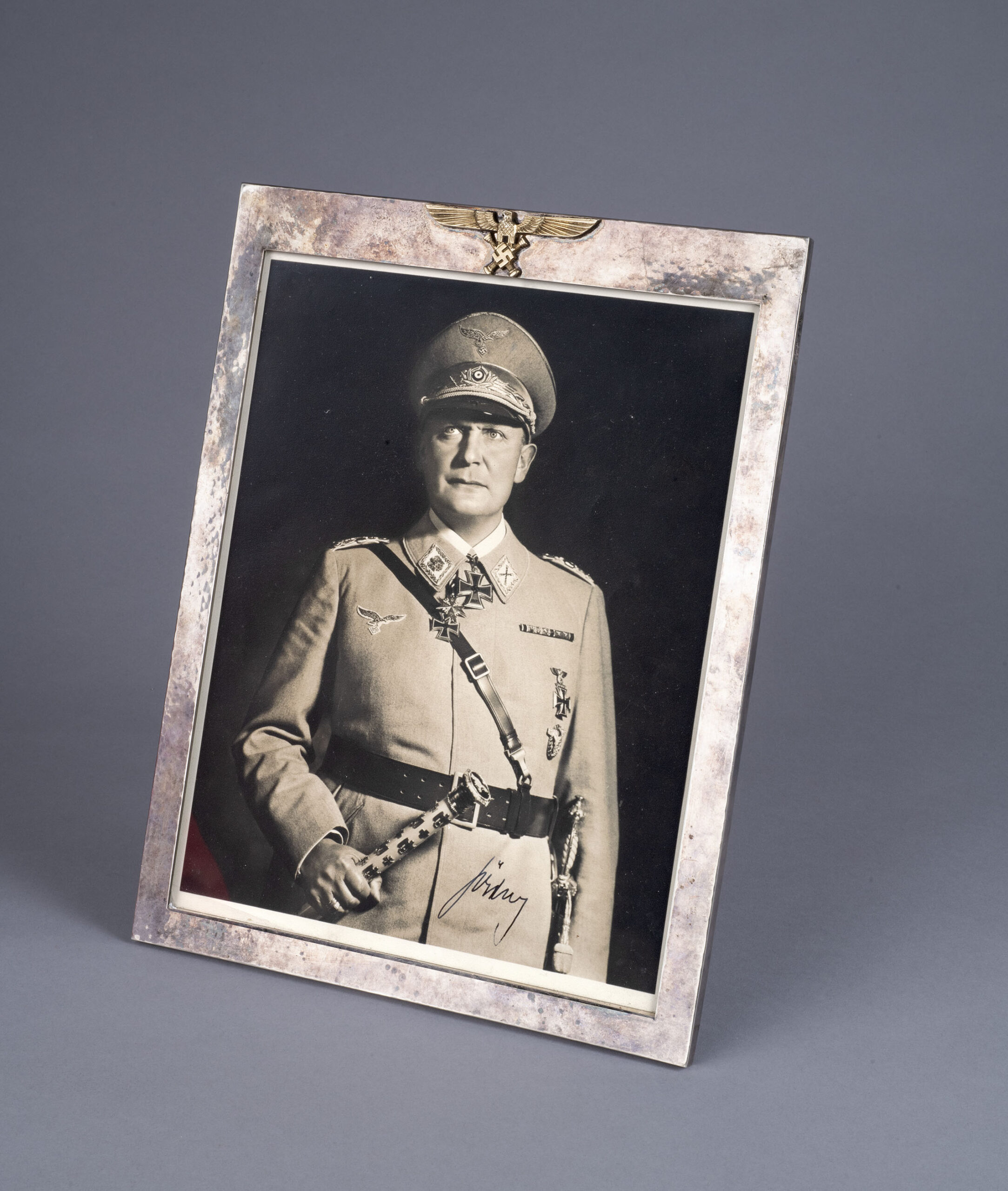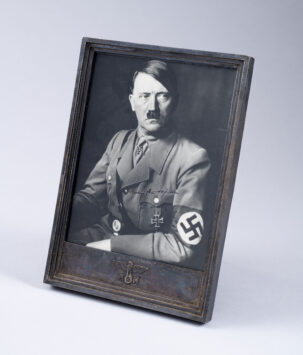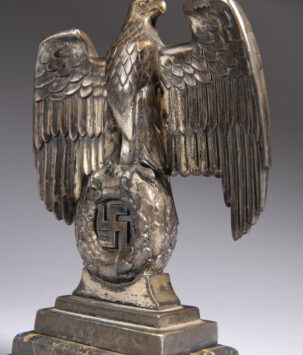Autographed Portrait of Hermann Göring
Signed portrait of Hermann Göring in its original silver presentation frame. The Paladin of the Führer as he was sometimes called, Göring was well-liked amongst the German populace for his perceived accessibility, sociability and humor, especially in comparison to other high-ranking Nazi officials. His antisemitism was also known to be more moderated compared to his peers such as Goebbels or Himmler, adopting a more pragmatic approach as the environment deemed it expedient.
The photograph, approx. 10 x 13 in. depicts the Reichsmarschall half-length in full dress uniform c. 1940, his marshal’s baton and awards readily visible. Based on research revealing a similar pose from the same photo session, it is presumed that this was the first official photograph taken to commemorate his 1940 promotion to Reichsmarschall des Grossdeutschen Reiches (Reich Marshal of the Greater German Reich) after the fall of France. The photograph is encased within a 10.75 x 13.75 in. hammered sterling silver frame, the top adorned with a 3.2 in. wide eagle clutching two crossed marshal’s batons and a swastika, a motif often used by the Reichsmarschall.
Hermann Göring was born in the Kingdom of Bavaria in 1893. A veteran fighter ace of the First World War, he distinguished himself as commander of Jagdgeschwader I (1st Fighter Squadron) succeeding Manfred von Richthofen, the Red Baron.
An early member of the Nazi Party, he partook in the Beer Hall Putsch of 1923 where he was wounded. He received morphine during his treatment during which he developed a lifelong addiction to the substance; it is said that this morphine habit contributed to his obesity. Following the establishment of the Third Reich, Göring rose to become the second most powerful man in Germany wielding great influence in both the civilian and military administration. After being named commander-in-chief of the Luftwaffe, courtesy of his experience as a bona fide First World War fighter ace, he was later bestowed with the honorary rank of Reichsmarschall upon the triumphant conclusion of the war in France campaign, specifically created for Göring’s exploits during the campaign. This rank effectively gave him seniority over all officers in the German armed forces.
Göring surrendered himself to the Allies in 1945 and was tested to have an IQ of 138 during captivity. He committed suicide by cyanide the night before his scheduled execution.
“The victor will always be the judge, and the vanquished the accused.” — Hermann Göring, 1945
Free shipping on orders over $50!
- Satisfaction Guaranteed
- No Hassle Refunds
- Secure Payments
Signed portrait of Hermann Göring in its original silver presentation frame. The Paladin of the Führer as he was sometimes called, Göring was well-liked amongst the German populace for his perceived accessibility, sociability and humor, especially in comparison to other high-ranking Nazi officials. His antisemitism was also known to be more moderated compared to his peers such as Goebbels or Himmler, adopting a more pragmatic approach as the environment deemed it expedient.
The photograph, approx. 10 x 13 in. depicts the Reichsmarschall half-length in full dress uniform c. 1940, his marshal’s baton and awards readily visible. Based on research revealing a similar pose from the same photo session, it is presumed that this was the first official photograph taken to commemorate his 1940 promotion to Reichsmarschall des Grossdeutschen Reiches (Reich Marshal of the Greater German Reich) after the fall of France. The photograph is encased within a 10.75 x 13.75 in. hammered sterling silver frame, the top adorned with a 3.2 in. wide eagle clutching two crossed marshal’s batons and a swastika, a motif often used by the Reichsmarschall.
Hermann Göring was born in the Kingdom of Bavaria in 1893. A veteran fighter ace of the First World War, he distinguished himself as commander of Jagdgeschwader I (1st Fighter Squadron) succeeding Manfred von Richthofen, the Red Baron.
An early member of the Nazi Party, he partook in the Beer Hall Putsch of 1923 where he was wounded. He received morphine during his treatment during which he developed a lifelong addiction to the substance; it is said that this morphine habit contributed to his obesity. Following the establishment of the Third Reich, Göring rose to become the second most powerful man in Germany wielding great influence in both the civilian and military administration. After being named commander-in-chief of the Luftwaffe, courtesy of his experience as a bona fide First World War fighter ace, he was later bestowed with the honorary rank of Reichsmarschall upon the triumphant conclusion of the war in France campaign, specifically created for Göring’s exploits during the campaign. This rank effectively gave him seniority over all officers in the German armed forces.
Göring surrendered himself to the Allies in 1945 and was tested to have an IQ of 138 during captivity. He committed suicide by cyanide the night before his scheduled execution.
“The victor will always be the judge, and the vanquished the accused.” — Hermann Göring, 1945







